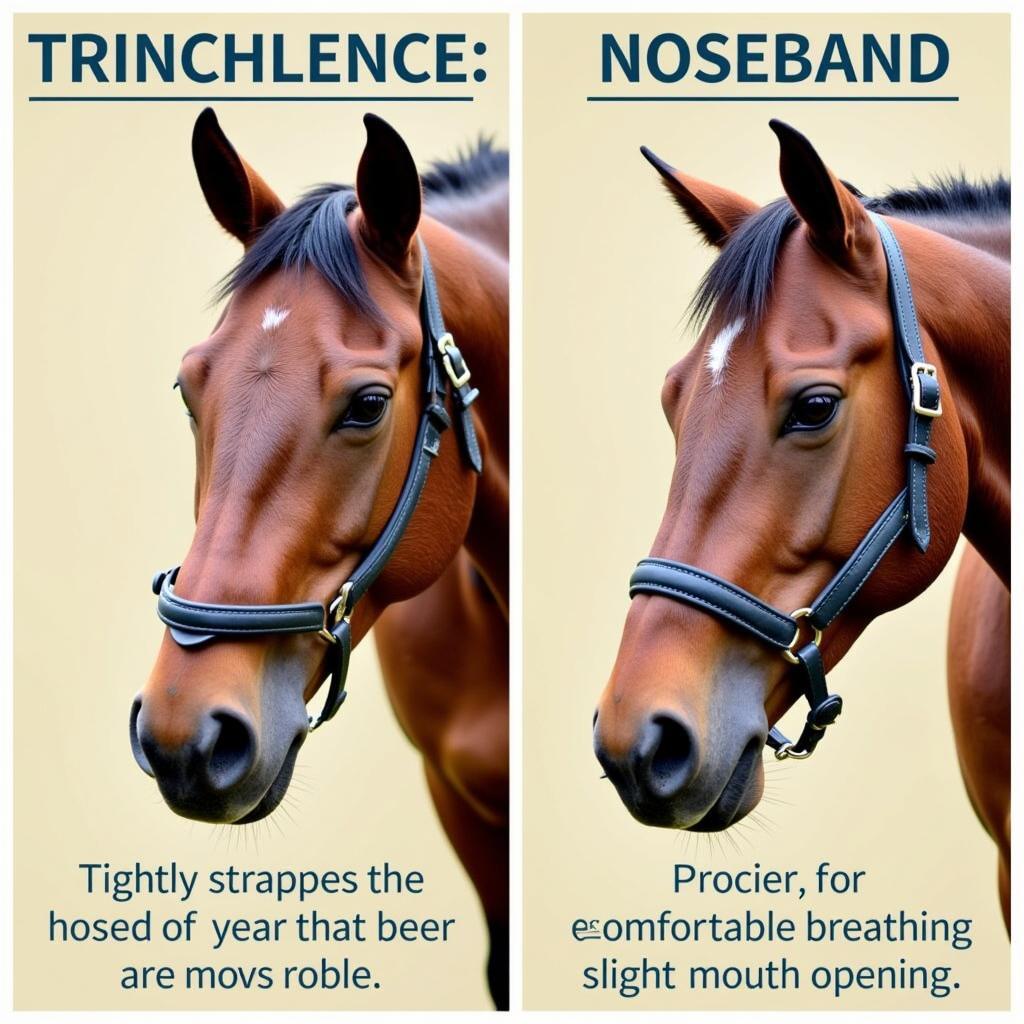The Horse Tie Down Noseband, often a topic of debate among equestrians, is a specialized piece of equipment designed to limit a horse’s head movement. It connects to the bit and runs down to attach between the horse’s nostrils. Understanding its purpose, proper usage, and potential implications is crucial for any horse owner considering this noseband. horse tie down and noseband
What is a Horse Tie Down Noseband?
The horse tie down noseband, also sometimes referred to as a standing martingale or gravitas, is a type of noseband that attaches to the cavesson noseband and runs down to a strap that splits and attaches to rings on each side of the bit. Its purpose is to prevent the horse from raising its head too high and evading the bit. This action can often be a sign of resistance or discomfort.
Why Use a Horse Tie Down Noseband?
Some riders use a horse tie down noseband to help control horses that tend to throw their heads up, especially when jumping or working in more collected gaits. It can provide a sense of security for the rider and, when used correctly and sparingly, can assist in retraining a horse to accept the bit.
 Horse Tie Down Noseband in Action
Horse Tie Down Noseband in Action
Potential Misuse and Concerns with the Tie Down
While the horse tie down noseband can be a useful tool in certain situations, it’s essential to acknowledge its potential for misuse. Incorrectly adjusted or used punitively, a tie down can cause discomfort, pain, and even injury to the horse. It’s vital to understand that a tie down noseband addresses a symptom, not the root cause of the behavior.
Proper Adjustment and Usage of a Tie Down Noseband
Correct adjustment is crucial for the horse’s well-being. The tie down should be adjusted so that the horse can still open its mouth slightly. horse nose band It shouldn’t be so tight that it restricts breathing or prevents the horse from flexing at the poll. A qualified trainer can provide guidance on appropriate adjustment and usage.
 Incorrect vs. Correct Tie Down Fit
Incorrect vs. Correct Tie Down Fit
Alternatives to the Horse Tie Down Noseband
Before resorting to a tie down, it’s essential to investigate other solutions. Often, the root cause of head tossing lies in discomfort from the bit, poor riding technique, or underlying dental or training issues. horse tie down, horse safety tie Exploring these possibilities with a vet and a qualified trainer is paramount. Alternative training methods and different types of bits might offer more humane and effective solutions.
When is a Tie Down Appropriate?
A tie down might be appropriate in limited situations, such as with a highly experienced rider on a very strong, experienced horse, particularly in disciplines like jumping where control is paramount. However, it should never be a substitute for proper training and addressing underlying behavioral causes.
Conclusion
The horse tie down noseband is a powerful tool that, when misused, can cause significant discomfort and harm to the horse. Before considering a tie down, consult with a qualified equine professional. Proper training, bitting, and addressing underlying issues offer a more humane and effective approach to achieving harmony and control while riding. bit and bridle horse Remember, understanding your horse’s behavior is key to choosing the right equipment and training methods.
Expert Insight:
Dr. Emily Carter, DVM, specializing in equine sports medicine, advises, “A tie down should always be a last resort, not a quick fix. Focus on addressing the root cause of head tossing before resorting to restrictive equipment.”
John Williams, a renowned horse trainer with over 30 years of experience, adds, “Proper training and communication are far more effective than relying on restrictive devices like tie downs. Work with your horse, not against them.”
Sarah Thompson, an equine behaviorist, further emphasizes, “Observe your horse’s behavior carefully. Head tossing is often a communication signal, not simply disobedience. Understanding the message is crucial.”
FAQ
-
What is the difference between a tie down and a martingale?
-
Can a tie down be used on young horses?
-
Are there different types of tie downs?
-
How do I know if my tie down is fitted correctly?
-
What are the signs of discomfort in a horse wearing a tie down?
-
Can a tie down cause damage to a horse’s nose?
-
What are some alternative solutions to using a tie down?
You might also be interested in reading more about horse safety tie.
For further assistance, please contact us: Phone: 0772127271, Email: [email protected] or visit us at QGM2+WX2, Vị Trung, Vị Thuỷ, Hậu Giang, Vietnam. We have a 24/7 customer service team.